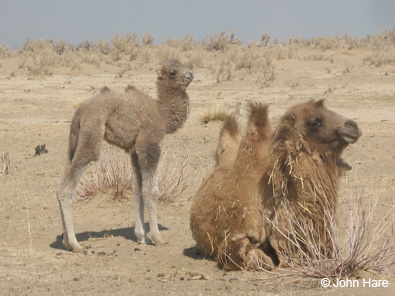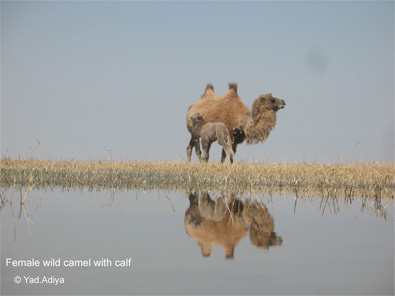We have just received the following appeal from John Hare at the Wild Camel Protection Foundation, with whom we work for the conservation of the Bactrian camel, EDGE mammal priority number 8:
In 2003, the Wild Camel Protection Foundation (WCPF) approached the Mongolian government to see if it were possible to be given a site where a wild Bactrian camel breeding programme could be established. The Mongolian government generously donated a suitable area, near Bayan Torooi, a small town near the Great Gobi Reserve A, where the wild Bactrian camel is protected in the wild in Mongolia. That place is called Zakhyn-Us.

At this site the Wild Camel Protection Foundation has erected a strong boundary fence, a barn for hay storage and three pens where captive wild camels and newly-born calves can find shelter from extreme weather conditions. This is important because the wild camel, which has a gestation period of 13 months, both mates and gives birth during the coldest months of the year – December to April. The Mongolian winter months can be very, very severe with temperatures dropping to -40 degrees centigrade. The fence was erected during October. Even during this month, a fire had to be lit to soften the ground before the fence posts could be driven into the soil. It was as hard as concrete.
A fresh water spring, which is just outside the fenced area, flows under the fence providing a year-round supply of fresh water. In the Lop Nur Wild Camel Nature Reserve in China, near China’s former nuclear test site, the water is salty, so salty that the domestic Bactrian camel will not touch it. Only the wild Bactrian camel manages to survive on this salt-water slush which bubbles up from underground springs. The wild camels in China would, however, much prefer to drink sweet water if they could get it. Fortunately, the captive wild camels at Zakhyn-Us have an ample supply, which is constantly replenished from underground.
During the summer months, when the frenzy of mating has subsided and the months of birth are at an end, the captive camels are released from the fenced area so that they can graze as a herd near their natural homeland. During this time they are constantly supervised by a Mongolian herdsman and his family who are employed to look after the captive wild camels. At the same time, the grass in the penned area is given a chance to recover.
The captive wild Bactrian camels that had been caught during the last 15 years by Mongolian herdsmen were formally grazing with domestic Bactrian camels. When they became difficult to handle they were frequently badly treated or even released back into the desert. Now they are kept together as one herd and are supervised by Mongolians who realise their great value. The success of the project is substantial. The wild camel numbers have increased from 12 to 24 in just four years. But now a crisis has arisen as this report from project director Bilgee indicates:
Our herdsman has phoned to inform that 1/3 of hay bought in the autumn for winter food is already finished. He explained to me that there it is very very cold and therefore the captive wild Bactrian camels must eat the hay every day more than four times. In connection with this I need to inform you urgently John that in west of Mongolia, especially Gobi-Altai has very harsh and severe winter since mid of December and covered most of areas with heavy snow. A meteorology office says that more snow will come and weather becomes worse then now and herders expected that the spring will be harder and longer as well as meteorology office. All western aimags under a National Emergency Management Agency control because of snow and cold.
Therefore, I talked and discussed with vet and herdsman what we need to do immediately. Urgently we need to buy more bales of hay, immediately nearest places which possibly has hay from Zakjyn-Us before all mountain passes are closed by snow and prices goes up of hays in countryside. We need at least 1200 bales of hay. It will be much expensive.
To be sure we have enough food for the camels until the spring the WCPF has just purchased 1500 bales of hay. It has been impossible to source all the hay locally and in addition we have had to incur very expensive transport costs to take the bales on the 1200 mile journey to the Breeding Centre.
Total cost to the Foundation: US$15,000
To donate to support the breeding centre please go to www.wildcamels.com and click on donations.
Many thanks indeed for YOUR help in saving one of the most CRITICALLY ENDANGERED large mammals in the world.
